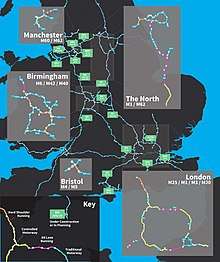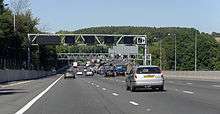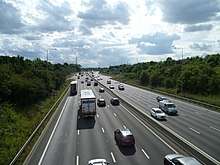Smart motorway
A smart motorway (formerly managed motorway and active traffic management), also known in Scotland as an intelligent transport system, is a section of motorway that uses active traffic management (ATM) techniques to increase capacity by use of variable speed limits and hard shoulder running at busy times. Benefits include smoother traffic flow, more reliable journey times, fewer road traffic collisions, and reduced noise and harmful vehicle emissions.[1][2] The term controlled motorway is sometimes used for schemes that use variable speed limits without hard-shoulder running (for example, the M25 motorway from J27 to J30).

As of 2019, smart motorways are mainly found in Great Britain, although the concept is also becoming common in Australia and New Zealand and some parts of Switzerland.
History
The traffic management technique, including hard shoulder running, was first used in its full specification in the UK on the M42 motorway in the West Midlands in 2006.[3][4] A higher speed limit of 60 miles per hour (97 km/h) was trialled on the southbound carriageway between junctions 4 and 3A from 2008 (a 10 miles per hour (16 km/h) increase on the previous maximum permissible speed).[5]
In 2007 plans were announced by the then secretary of state for transport, Ruth Kelly, to extend the scheme to two sections of the M6 motorway near Birmingham (4-5 and 8a-10) by 2011 at a cost of £150 million.[6][7] The emergency refuges were to be extended to every 800 metres (0.50 mi) on the roll out.[8] A study into the use of ATM on the M1, M4, M20 and M25 motorways was also announced,[6] however the Department for Transport had decided to proceed with a scheme to widen sections of the M25.[9]
From 2013 the current term smart motorway was used by the Highways Agency (now Highways England) to promote the technology to road users.[10]
Contracts
A £2 billion contract was announced to extend the scheme to sections of the M1, M4, M5, M6, M60 and M62 in February 2010[11] with a further announcement by the new government in October 2010.[12] The contract was awarded to four delivery partners Balfour Beatty, Carillion and joint ventures BAM Nuttall/Morgan Sindall Group and Costain Group/Serco.[13] In January 2012, Carillion won the contract for M6 junctions 5 - 8 near Birmingham for £126 million.[13]
In early 2018, the contracts previously awarded to Carillion were taken on by Kier, following the collapse of Carillion.[14]
Map

The map to the right visually represents the operational and under construction elements of the UK's smart motorway system as of June 2017.[15]
Effectiveness
In 2007 it was estimated that ATM could be introduced within two years at a cost of around £5-15 million per mile[16] as opposed to 10 years and £79 million per mile for widening.[17][18]
The M42 scheme was initially run as an experiment and a Highways Agency report into the first six months of the scheme showed a reduction in variability journey times of up to 27%.[6][8] The journey time statistics can be broken down to show that northbound journey times were reduced by 26%, equating to an average reduction of 4 minute as compared to the period when the variable speed limits were on but the hard shoulder was not being used and 9% southbound (equating to 1 minute) during the afternoon rush hour.[19] The report also indicated a fall in the number of accidents from over 5 a month to 1.5 per month on average.[6][8] The Agency did state that normally accident statistics should be compared over a 3-year period, so the initial results should be treated with caution. They also stated that no accidents had been caused by hard shoulder use as a normal lane.[19] The report also stated that there had been a 10% fall in pollution and 4% fall in fuel consumption.[6] The report also indicated a compliance rate of 98% to the indicated speed limits when using the hard shoulder.[19] For comparison before the introduction of mandatory speed limits at road works, the compliance rate was 10% as opposed to 89% afterwards, showing a similar effect.[20]
Criticisms
The Campaign for Better Transport argued that whilst it would reduce the need for widening schemes, it did nothing to reduce traffic and CO2 emissions. Friends of the Earth criticised the scheme as "widening on the cheap" and also pointed to a possible increase in vehicle emissions.[6] Highways England argue that ATM reduces the environmental impact in regards to widening as it is carried out within the existing boundaries of the motorway as well as a possible improvement in local air quality due to smoother traffic flow.[21]
The RAC cited a study in the Netherlands that showed drivers using the hard shoulder when they were not permitted, increasing the risk of a collision for vehicles stopped. The Royal Society for the Prevention of Accidents also expressed concern that emergency services would take longer to reach an incident.[18] The Highways Agency rejected this concern based on the 5,000 miles (8,000 km) of dual carriageway that does not have a hard shoulder.[22] Disability groups were concerned that some drivers would not be able to access the emergency phones or even exit their vehicles, leaving them at increased risk.[22] Ruth Kelly, former Secretary of State for Transport stated that these schemes were useful, but that motorway widening would still be considered where it was appropriate.[18]
The scheme has attracted criticism from motoring organisations such as the AA, who in 2018 reported that many members were concerned that speed limits were being imposed without good cause in situations where traffic was light.[23] In response, Highways England stated that they had "started a comprehensive review of how variable speed limits are set, including the amount of time they are visible to drivers"[23].
A campaign "Smart Motorways Kill" was set up in 2019 after the death of Jason Mercer and Alexandru Murgeanu on the M1 northbound near junction 34. They were killed by a heavy goods vehicle after they had pulled over after a minor accident on this "Smart Motorway" section.[24]
In January 2020, it was announced that a review was planned after freedom of information requests showed that near misses had increased up to 20-fold, and that 38 people had died. The emergency refuge areas (ERA) were placed 500 metres (0.31 mi) apart on the M42 pilot scheme, but can be 2.5 kilometres (1.6 mi) apart on stretches of the M25. Only 9% of drivers feel safe while using smart motorways. Some of the extra capacity is negated by drivers terrified to drive on the inside lane and not using them.[25][26]
A BBC Panorama aired on 27 January 2020 accused smart motorways of being responsible for multiple deaths in the UK.
On 28 January 2020 Police Federation of England and Wales chief, reported The Times newspaper, John Apter said he did not "like the term 'smart motorways' because it infers they’re a good idea. They’re anything but" and "a recipe for disaster. It’s a death trap. It’s inherently dangerous and putting lives at risk."[27]
In January 2020, all Smart Motorways were put under review to address safety concerns and determine an action plan. No new Smart Motorways would open until this review was published. On the 12th March 2020, the review and action plan was published. It stated changes to the standards for new smart motorways (ones which had not started construction) such as a reduction from upto 1.5 miles to 1 mile between Emergency refuge areas (or other qualifying areas) and Stranded vehicle detection radars to be installed as part of the project. Other actions it required to be taken is for all Dynamic Hard Shoulder Motorways to be converted into All-Lane-Running by March 2025, Stranded Vehicle Detection radars to be installed on all Smart Motorways within 36 months & a potential national programme to install more ERAs on current smart motorways.[28]
Signage

Early systems used dot matrix signs on gantries to display short text messages, with smaller variable signs above each lane and to the sides of the carriageway. Current smart motorway systems often use the "MS4" sign type[29] which can include pictograms from the Traffic Signs Regulations and General Directions.
In 2017, Highways England trialled a new type of emergency area on the M3 that would be more visibly obvious to motorists.[30] A new sign accompanied the trial which is similar in design to European emergency area signs. These changes have subsequently been trialled on the M5 and M25 with the signs being authorised by the Department for Transport for further use.[31][32]
Operation and variants
Highways England, the South Wales Trunk Road Agent (there are no motorways in North Wales), Transport NI (Northern Ireland) and Transport Scotland are responsible for the construction and maintenance of smart motorways in their respective countries.[33]
Controlled motorway

Variable speed limits with the hard shoulder operating as it would on a conventional motorway. They have most often been installed where a motorway has previously been widened but with a discontinuous hard shoulder to incorporate existing bridges, therefore using the hard shoulder as a running lane is ruled out. Existing gantries are upgraded to support signals capable of displaying a mandatory speed limit and speed cameras.
Locations






- Notes
- ^ 1: A bus lane is in operation on the southbound hard-shoulder between J1a and J2a and on the approach to the southbound M9. The hard shoulders on the Queensferry Crossing are opened to buses when the Forth Road Bridge is closed.
Dynamic hard shoulder
Variable speed limits with the hard shoulder selectively opened as a running lane during periods when traffic levels are too high for only three lanes of running traffic. When activated, vehicles can use the hard shoulder as a running lane. All lanes are limited to a maximum of 60 mph, but these can be lowered further. Studies have shown that many users struggle to understand the complex signs and signals, which gave rise to plans in the mid-to-late 2020s to change the dynamic hard shoulder into a permanent running lane, thereby making these schemes all lane running.
Locations





All lane running

Variable speed limits with the hard shoulder removed and converted to a permanent running lane.
Through-junction running
Isolated stretches on a smart motorway where the hard shoulder becomes a permanent running lane through a junction and immediately surrounding the slip roads.
Locations



Under construction
The following schemes are under construction:






Planned
To begin construction before 2020 (RIS1)







Timeline of introduction
1995
M25: J10-J15 (first mandatory variable speed limits used on the British motorway network)
2001
M25: J15-J16
2005
M42: J3a-J7 (pilot dynamic hard shoulder scheme, originally known as active traffic management)
2010
- M6: J8-J10a
- M20: J4-J7
- M1 (Northern Ireland): J1-J3 (only variable speed limits on a motorway in Northern Ireland)
- A12 Westlink (Northern Ireland): M1-A501 (only variable speed limits on a primary A-road in Northern Ireland)
2020
Statutory instruments
- The M25 Motorway (Junctions 10 to 15) (Variable Speed Limits) Regulations 1995
- The M25 Motorway (Junctions 10 to 16) (Variable Speed Limits) Regulations 2001
- The M42 (Junctions 3A to 7) (Actively Managed Hard Shoulder and Variable Speed Limits) Regulations 2005
- The M42 (Junctions 3A to 7) (Actively Managed Hard Shoulder and Variable Speed Limits) (Amendment) Regulations 2009
- The M40 Motorway (M40 Junction 16 to M42 Junction 3A) (Northbound) (Variable Speed Limits) Regulations 2009
- The M42 Motorway (Junctions 7 to 9) (Variable Speed Limits) Regulations 2009
- The M6 Motorway (Junctions 4 to 5) (Actively Managed Hard Shoulder and Variable Speed Limits) Regulations 2009
- The Motorway M1 and Westlink A12 (Speed Limits and Variable Speed Limits) Order (Northern Ireland) 2010
- The M6 Motorway (Junctions 8 to 10A) (Actively Managed Hard Shoulder and Variable Speed Limits) Regulations 2010
- The M20 Motorway (Junctions 4 to 7) (Variable Speed Limits) Regulations 2010
- The M4 Motorway (West of Junction 23A (Magor) to East of Junction 29 (Castleton)) (Variable Speed Limits) Regulations 2011
- The M1 Motorway (Junctions 25 to 28) (Variable Speed Limits) Regulations 2011
- The M1 Motorway (Junctions 6A to 10) (Variable Speed Limits) Regulations 2011
- The M25 Motorway (Junctions 2 to 3) (Variable Speed Limits) Regulations 2012
- The A823(M) Pitreavie Spur Trunk Road (Variable Speed Limits) Regulations 2012
References
- "M20 Junctions 4 - 7 Controlled Motorways". Archived from the original on 10 August 2012.
- "Highways England - Our Road Network".
- "Managed Motorways". www.highways.gov.uk. Highways Agency. November 2009. Archived from the original on 6 June 2011.
- "Active Traffic Management". www.highways.gov.uk. Highways Agency. Archived from the original on 3 March 2010. Retrieved 20 September 2018.
- "60mph speed limit on the M42 Active Traffic Management pilot". www.dft.gov.uk. Department for Transport. Archived from the original on 6 August 2008. Retrieved 10 December 2008.
- "'Extra lane' plan to be extended". BBC News. British Broadcasting Corporation. 25 October 2007. Retrieved 31 December 2007.
- "M42 Active Traffic Management Scheme, Birmingham". www.roadtraffic-technology.com. Verdict Media. Retrieved 20 September 2018.
- Meikle, James (26 October 2007). "Kelly extends experiment to let drivers use hard shoulder". The Guardian. London: Guardian News and Media Limited. Retrieved 31 December 2007.
- Milmo, Dan (24 December 2007). "Plan to open up hard shoulder on M25 to ease traffic shelved". The Guardian. London: Guardian News and Media Limited. Retrieved 31 December 2007.
- Marshall, Chris. "Smart Motorways". www.roads.org.uk. roads.org.uk. Retrieved 9 September 2018.
- "£2 Billion In Managed Motorway Schemes Starts On UK Highways". GovMonitor. 18 February 2010.
- "Transport Secretary gives the go-ahead to 24 New Schemes and announces over £600M of further funding". Department for Transport. 26 October 2010. Archived from the original on 30 October 2010.
- Bottom, Hannah (3 January 2012). "Carillion scoops £126M Managed Motorway scheme". New Civil Engineer. Retrieved 27 January 2020.
- Curry, Rihannon (22 January 2018). "Kier takes on Carillion staff for HS2 and motorways work". The Daily Telegraph. Telegraph Media Group. Retrieved 27 July 2018.
- "Smart Motorways UK | Smart Motorway Map". Keith Michaels PLC. Retrieved 3 July 2017.
- Cleland, Gary (26 December 2007). "No hard shoulder driving on M25". The Daily Telegraph. London: Telegraph News and Media. Retrieved 31 December 2007.
- Webster, Ben (25 October 2007). "Hard-shoulder driving lies ahead for motorways in effort to reduce congestion". The Times. London: News International Limited. Retrieved 31 December 2007.
- Strange, Hannah; Ben Webster (25 October 2007). "Hard shoulder scheme cut journey times on motorways". Times Online. London: News International Limited. Retrieved 31 December 2007.
- Highways Agency (25 October 2007). "M42 Active Traffic Management Results –First Six Months" (PDF). Department for Transport. Archived from the original (PDF) on 6 March 2008. Retrieved 31 December 2007.
- Murray, Louise (26 October 2005). "Smooth-flowing traffic is on the way". Society - The Guardian. London: Guardian News and Media Limited. Retrieved 31 December 2007.
- "How does it affect the environment?". M42 Jct 3a - Jct 7 Active Traffic Management. Highways Agency. Retrieved 31 December 2007.
- Sturcke, James; Agencies (31 August 2006). "Motorway hard-shoulder use 'could cost lives'". Guardian Unlimited. London: Guardian News and Media Limited. Retrieved 31 December 2007.
- Rodger, James (30 April 2018). "Thousands of 'smart motorway' drivers on M6 may have been wrongly fined". Birmingham Mail. Birmingham: Reach Plc.
- "About Us". Smart Motorways Kill. Retrieved 2 July 2020.
- Topham, Gwyn (26 January 2020). "UK's smart motorways to be reviewed after huge rise in near-misses". Retrieved 27 January 2020.
- "38 killed on smart motorways in last five years". BBC News Online. 26 January 2020. Retrieved 26 January 2020.
- Karim, Fariha; Paton, Graeme (29 January 2020). "Smart motorways are death traps, says Police Federation chief John Apter". The Times. Retrieved 3 February 2020.(subscription required)
- "Smart motorway evidence stocktake and action plan". GOV.UK. Retrieved 12 April 2020.
- Highways England http://www.standardsforhighways.co.uk/ha/standards/ians/pdfs/ian109.pdf
- "Orange is the new grey". Roads.org.uk. Retrieved 11 July 2020.
- "Orange appeal". Roads.org.uk. Retrieved 11 July 2020.
- "Emergency Refuge Areas, Smart Motorways M3 J2-4a, M5 J4a-6 & M25 J23-27, Highways England" (PDF). Retrieved 11 July 2020.
- "What Is A Smart Motorway? - All Car Leasing Blog". www.allcarleasing.co.uk. Retrieved 28 January 2020.
- "M1 Junctions 6A - 10 Controlled Motorway". www.highways.gov.uk. Highways Agency. Archived from the original on 21 September 2011. Retrieved 25 July 2018.
- "Major roads investment in the Midlands". www.gov.uk. HM Government. 1 December 2014. Retrieved 12 February 2015.
- "Road Investment Strategy: Investment Plan - commitments" (PDF). www.assets.publishing.service.gov.uk. Department for Transport. Retrieved 29 July 2018.
- "M1 junctions 23a to 25: smart motorway". www.highwaysengland.co.uk. Highways England. Retrieved 30 August 2018.
- "M1 J25-28 Widening Scheme". www.highways.gov.uk. Highways Agency. Archived from the original on 10 August 2012. Retrieved 25 July 2018.
- "M4 Variable Speed Limit". www.traffic-wales.com. Traffic Wales. Archived from the original on 22 October 2011. Retrieved 27 July 2018.
- ". M4 Junctions 24 - 28 Variable Speed Limit Scheme - Your Questions Answered..." (PDF). www.traffic-wales.com. Traffic Wales. January 2011. Retrieved 27 July 2018.
- "M6 Junction 10a to13: Smart Motorway". www.highways.gov.uk. Highways England. Archived from the original on 2 June 2015. Retrieved 29 July 2018.
- "Intelligent Transport System (ITS)". www.theforthbridges.org. Transport Scotland. Retrieved 16 September 2018.
- "M20 Junctions 4 - 7 Controlled Motorways". www.highways.gov.uk. Highways Agency. Archived from the original on 9 September 2012. Retrieved 29 July 2018.
- "M25 Junction 1b - 3". www.highways.gov.uk. Highways Agency. Archived from the original on 10 November 2010. Retrieved 29 July 2018.
- "M25 Junctions 5-7: Smart Motorway". www.highways.gov.uk. Highways England. Archived from the original on 2 June 2015. Retrieved 31 July 2018.
- "M25 speed limit work in Surrey comes to end". BBC News. British Broadcasting Corporation. 16 April 2011. Retrieved 31 July 2018.
- "M25 Controlled Motorway - January 2013 - Consultation Document - M25 Junction 16 to 23" (PDF). www.assets.highways.gov.uk. Highways Agency. January 2013. Retrieved 31 July 2018.
- "M25 Jct 27 to 30 Widening". www.highways.gov.uk. Highways Agency. Archived from the original on 10 August 2012. Retrieved 2 September 2018.
- "The M25 Motorway (Junctions 27 to 30) (Variable Speed Limits) Regulations 2013". www.legislation.gov.uk. The National Archives. 11 December 2013. Retrieved 2 September 2018.
- "The Birmingham Motorway 'Box'". www.highways.gov.uk. Highways Agency. Archived from the original on 19 December 2010. Retrieved 2 September 2018.
- "M60 junction 8 to M62 junction 20". www.highwaysengland.co.uk. Highways England. Retrieved 29 July 2018.
- "M60/M62 smart motorways - Public information exhibition" (PDF). www.assets.highways.gov.uk. Highways England. Retrieved 29 July 2018.
- "M62 Junctions 25 to 30: Smart Motorway". www.highways.gov.uk. Highways Agency. Archived from the original on 22 December 2014.
- "M1 Junction 10-13 Improvements: Smart Motorway". www.highways.gov.uk. Highways Agency. Archived from the original on 21 November 2013. Retrieved 16 September 2018.
- "M4 Junction 19-20 and M5 Junction 15-17: Smart Motorway". www.highways.gov.uk. Highways Agency. Archived from the original on 11 January 2015. Retrieved 16 September 2018.
- "M6 Birmingham Box Phase 3: Smart Motorway". www.highways.gov.uk. Highways England. Archived from the original on 9 February 2016. Retrieved 2 September 2018.
- "M1 Junctions 19 to 16 All Lane Running". www.highwaysengland.co.uk. Highways England. Retrieved 21 September 2018.
- "M1 Junctions 28-31: Smart Motorway". www.highways.gov.uk. Highways England. Archived from the original on 11 August 2016. Retrieved 21 September 2018.
- "M1 J32 to J35a Managed Motorway". Highways Agency.
- "M1 Junctions 39-42: Smart Motorway". Highways Agency. Retrieved 10 February 2015.
- "M3 J2-4a Managed Motorway". Highways Agency.
- "M5 Junctions 4a to 6 Smart Motorway". www.highways.gov.uk. Highways England. Retrieved 15 January 2016.
- "M6 Junctions 16-19: Smart Motorway". www.highways.gov.uk. Highways England. Retrieved 29 February 2016.
- "M25 Junctions 23-27: Smart Motorway". www.highways.gov.uk. Highways England. Archived from the original on 2 June 2015.
- "M1 junction 13 to junction 16: smart motorway". www.highwaysengland.co.uk. Highways England. Retrieved 30 August 2018.
- "M4 junctions 3-12: smart motorway". www.highwaysengland.co.uk. Highways England. Retrieved 28 August 2018.
- "M6 junction 2 to junction 4: smart motorway". www.highwaysengland.co.uk. Highways England. Retrieved 20 September 2018.
- "M6 junction 13 to junction 15 smart motorway". www.highwaysengland.co.uk. Highways England. Retrieved 20 September 2018.
- "M23 junctions 8 to 10: smart motorway". www.highwaysengland.co.uk. Highways England. Retrieved 20 September 2018.
- "M62 junction 10 to junction 12: smart motorway". www.highwaysengland.co.uk. Highways England. Retrieved 19 August 2018.
- "Major roads investment in London and the south east". www.gov.uk. HM Government. 1 December 2014. Retrieved 3 April 2015.
- "M40/M42 Interchange: smart motorway". www.highwaysengland.co.uk. Highways England. Retrieved 27 August 2018.
- "M56 junctions 6 to 8 smart motorway". www.highwaysengland.co.uk. Highways England. Retrieved 27 August 2018.
- "Major roads investment in the north west". Gov.uk. Retrieved 10 February 2015.
- "M62 Junction 20 to Junction 25 Smart Motorway". www.highwaysengland.co.uk. Highways England. Retrieved 26 August 2018.
- "Major roads investment in the north east and Yorkshire". www.gov.uk. HM Government. 1 December 2014. Retrieved 28 August 2018.
- "A1(M) Junction 6 to Junction 8 Smart Motorway". www.highwaysengland.co.uk. Highways England. Retrieved 8 September 2018.
- "Major roads investment in the east of England". www.gov.uk. HM Government. 1 December 2014. Retrieved 8 September 2018.
.svg.png)